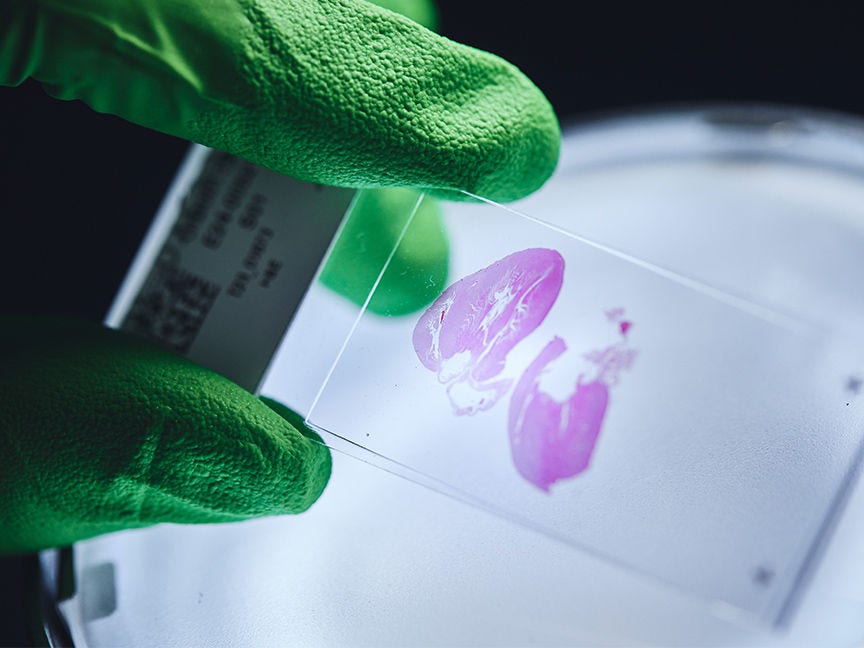
Our scientific groundwork
Paving the way for the future of medicine
BioNTech’s pioneering messenger RNA (mRNA) research laid the groundwork for developing the world’s first ever approved mRNA medicinal product. Originally focused on creating mRNA-based cancer immunotherapies, BioNTech’s co-founders, Ugur Sahin and Özlem Türeci, have built a diversified portfolio encompassing various therapeutic modalities to address cancer, as well as infectious, and other serious diseases.
Turning challenges into breakthroughs: BioNTech’s innovations in mRNA research
When optimizing mRNA for the development of mRNA cancer immunotherapy candidates, BioNTech had to face three major challenges previously considered insurmountable:

mRNA cancer immunotherapies needed to be potent and induce a large number of immune cells, as even small tumors comprise millions of cancer cells.

Tumor characteristics are unique to each individual patient. This required an easily adaptable approach to tailoring mRNA cancer immunotherapies to each patient's distinctive antigen profile.

Swift manufacturing of these individualized mRNA cancer immunotherapies was essential to effectively address cancer progression.
Over two decades, Ugur Sahin, Özlem Türeci, and their teams achieved significant scientific and technological breakthroughs to unlock the full potential of mRNA for cancer immunotherapy:
They worked on mRNA’s structural components – such as the cap, poly-A tail and its untranslated regions – to enhance intracellular stability of mRNA and antigen translation efficiency, increasing its expression by over 1,000-fold.
They improved the clinical activity of mRNA cancer immunotherapy approaches by discovering mechanisms of selective mRNA uptake in dendritic cells, especially within lymphoid tissues, boosting immune responses.
They identified a method to improve antigen presentation by dendritic cells for stronger T cell responses by coupling the antigens with a Major Histocompatibility Complex I (MHC-I) trafficking signal.
Based on all of the discoveries listed above, they developed an individualized mRNA immunotherapy approach, potentially adaptable to different cancer types and manufactured for use in clinical trials within weeks.
Refining breakthroughs: Diverse approaches for mRNA optimization
Over several years, Ugur Sahin, Özlem Türeci, and other researchers worldwide solved fundamental issues of RNA-based medicines, using different approaches. Key challenges included addressing inflammation from immune responses to high doses and improving protein production.
Focusing on mRNA therapies for the treatment of strokes and cerebral diseases, researchers discovered that replacing the nucleotide uridine in mRNA with naturally occurring alternatives such as methylpseudouridine, suppressed RNA-related immune activation and inflammatory responses1,2, allowing for higher doses of the treatment.
Sahin und Türeci pursued a different approach by developing designs for mRNA’s structural components3,4. They increased mRNA’s intracellular stability and translation efficacy, particularly in immune cells5, thereby enabling lower doses to induce significant, strong immune responses. mRNA thus became potent enough to be used in the pharmaceutical setting.
Optimizing mRNA: Structural improvements to make mRNA more powerful
5’ cap
By incorporating a unique cap analogue, Sahin and Türeci enhanced translational performance, stabilizing the mRNA molecule and directing the immune response.
3’ untranslated region
Sahin and Türeci’s composition and structural innovations of the 3’ untranslated regions are crucial for ensuring mRNA’s intracellular stability.
Poly(A) tail
Through extensive research on the structure of the poly(A) tail and mRNA’s translational performance, Sahin and Türeci have developed tailored mRNA template designs.
mRNA formats
We must avoid immunogenic reaction against mRNA drugs in applications where therapeutic proteins are produced, such as in our RiboMab and RiboCytokine platforms. BioNTech has significant expertise in incorporating naturally occurring modified nucleosides into our therapeutic mRNAs. We have demonstrated that incorporating a variety of modified nucleosides in the manufactured mRNA suppresses its intrinsic immune activation while leading to superior protein production over time. Deimmunizing mRNA by incorporating modified nucleosides helps to avoid production of anti-drug antibodies and broadens the therapeutic application of these types of mRNA drugs.
Our saRNA preclinical candidates use the concept of viral replication while not being an infectious, disease-causing agent themselves. saRNA resembles the process of conventional mRNA encoding the protein of interest but also a polymerase – called replicase – that multiplies part of the mRNA within the target cell. During self-amplification inside the cell, a double-stranded RNA intermediate is generated, which is recognized by intracellular immune sensors. This makes saRNA a very potent activator of the immune system and therefore an excellent category of immunotherapy.
Our taRNA technology is an advancement of the saRNA platform. By separating the target mRNA to be amplified from the replicase-encoding mRNA, we can develop more applications. This makes the development of therapeutic mRNAs even more flexible, as the replicase can amplify mRNA encoding of several different proteins. The technology allows us to produce the replicase in advance for use with different vaccine candidates. taRNA is a proprietary mRNA format that we believe is well-suited for prophylactic vaccines to prevent infectious diseases.
Delivery formulations
BioNTech has made great progress in developing its mRNA cancer immunotherapy candidates and mRNA vaccine approaches against infectious diseases. A key achievement is the development of lipid nanoparticle formulations for well-protected and targeted mRNA delivery. Sahin and Türeci discovered the mechanism of selective mRNA uptake into dendritic cells and, with their team, developed a lipid nanoparticle formulation that exploited this mechanism to specifically deliver RNA to these cells.
Today, BioNTech exploits various mRNA delivery formulations, each tailored for specific functions and optimized according to application and delivery route:
For other applications, we encapsulate our mRNA in LNPs. These formulations are suitable for our RiboCytokine platform, for example. LNPs have also been used for our COVID-19 vaccine.
Our portfolio also includes polyplexes, used in some of our discovery programs, where the mRNA is bound to a polymer and forms nanoparticles.
Explore more

Global health

Investors

Careers
Sources
1 Karikó K et al., Incorporation of Pseudouridine Into mRNA Yields Superior Nonimmunogenic Vector With Increased Translational Capacity and Biological Stability. Molecular Therapy (2008)
2 Karikó K et al., Suppression of RNA recognition by Toll-like receptors: the impact of nucleoside modification and the evolutionary origin of RNA. Immunity (2005)
3 Holtkamp S et al., Modification of antigen-encoding RNA increases stability, translational efficacy, and T-cell stimulatory capacity of dendritic cells. Blood (2008)
4 Kuhn AN et al., Phosphorothioate cap analogs increase stability and translational efficiency of RNA vaccines in immature dendritic cells and induce superior immune responses in vivo. Gene Therapy (2010)
5 Kreiter S et al., Increased Antigen Presentation Efficiency by Coupling Antigens to MHC Class I Trafficking Signals. The Journal of Immunology (2008)
6 Kreiter S. et al., Mutant MHC class II epitopes drive therapeutic immune responses to cancer. Nature (2015)